![]()
![]()
![]()
Use LEFT and RIGHT arrow keys to navigate between flashcards;
Use UP and DOWN arrow keys to flip the card;
H to show hint;
A reads text to speech;
49 Cards in this Set
- Front
- Back
|
3 main types of fuel and characteristics |
Oil - transportable - medium energy content Used for transport (high energy density) Gas - stationary use - cleanest - difficult to transport Coal -stationary power - lowest energy content - not easily transportable |
|
|
Oil refinery process |
Fractional distillation - lowest boiling point to highest |
|
|
Reserves |
- Proved reserves (P90): 90% confidence of being recovered (1P) - Unproved reserves: • Probable reserves (P50) 50% confidence of being recovered (2P) • Possible reserves (P10) atleast 10% chance of being recovered (3P) |
|
|
Resources |
Reserves plus other potential sources - Contingent resources: Quantities of petroleum potentially recovered from known accumulations - Prospective resources: Quantities of petroleum potentially recovered from undiscovered accumulations |
|
|
Petrol |
- Boiling ranges between 25 and 225°C - C8H18 |
|
|
Diesel |
- Boiling ranges from 180 to 360°C - C12H23 |
|
|
Difference between diesel and petrol (Molecular weight) |
-Molecular weight and boiling point greater for diesel, makes it suitable for large capacity compression ignition engines - leads to high T and P - Diesel refined at high T - Diesel is denser and less explosive |
|
|
Fuel Volatility |
- Tendency of a liquid to evaporate - Fuel must contain large proportion of volatile components to ensure good cold start - Not too high or else vapour lock |
|
|
Vapour lock |
When liquid fuel changes state from liquid to gas whilst still in fuel delivery system |
|
|
Flash point |
Lowest temperature of a flammable liquid at which it can form an ignitable mixture in air |
|
|
Fire point |
Higher temp than flash point Where vapour continues to burn after being ignited |
|
|
Calorific value |
Index of energy in fuel Low value, more fuel needed |
|
|
Vapour/Liquid ratio |
Ability of fuel to form bubbles |
|
|
Knock inhibitors |
Stops engine knock by increasing octane number |
|
|
Engine knock |
Irregular combustion/explosions in petrol engine, a-f mixture ignites too early or spontaneously |
|
|
How to determine fuel quality |
High Octane number for petrol High Cetane number for diesel |
|
|
octane/cetane rating |
-Measure resistance to knocking/igniting randomly -Inverse relation between them -Measures fuels tendency to burn |
|
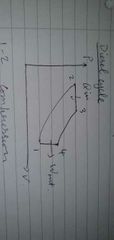
Diesel cycle |
1-2 compression2-3 fuel injection, expansion at const P3-4 Adiabatic expansion4-1 const volume heat rejection |
|
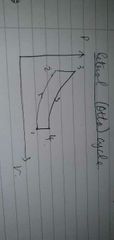
Petrol (Otto) cycle |
1-2 adiabatic compression 2-3 heat addition at const volume 3-4 adiabatic expansion 4-1 heat rejection |
|
|
Difference between diesel and petrol (Otto) cycle |
Heat added for diesel at const P but const vol for Otto |
|
|
Ideal dual cycle |
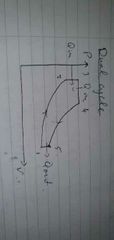
|
|
|
Indicator diagram |
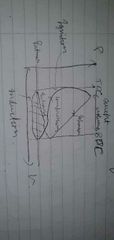
|
|
|
Indicated work on indicator diagram |
Space between expansion and compression minus pumping work |
|
|
Thermal efficiency |
Indicated power output divided by fuel power input |
|
|
Indicated work/cycle formula |
Indicated mean effective pressure (imep) x Vs (Swept volume) |
|
|
Brake mean effective pressure |
Indicated work minus engine friction |
|
|
Brake work/cycle formula |
Brake mean effective pressure (bmep) x Vs (swept volume) |
|
|
Mechanical efficiency |
bmep divided by imep |
|
|
Brake power output |
Bmep x Vs x N N is number of working strokes N= rpm/120 for 4 stroke N= rpm/60 for 2 stroke |
|
|
Volumetric efficiency |

|
|
|
Specific power output (bhp/litre) or (bhp/engine weight) |
Proportional to (N times thermal, mechanical and volumetric efficiencies) divided by weight |
|
|
Brake thermal efficiency |
Brake work divided by Qin |
|
|
How engine works |
- compress working fluid - injection of heat into fluid (heat input) - recover a greater amount of work (converted from heat) - removal of heat |
|
|
2 stroke engines |
Petrol 2 stroke light weight and portable - for motor cycles Diesel 2 stroke for large applications - marine propulsion, locomotives etc |
|
|
2 stroke IC engine |
stroke 1: fuel air mixture introduced into the cylinder then compressed stroke 2: products expands doing work and then exhausted |
|
|
Advs and Disadvs of 2 stroke ICs |
Advs: power to weight ratio, simple design Disadvs: Emission problems and cooling and lubricating requirements |
|
|
4 stroke spark ignition engine |
Stroke 1: a/f mixture introduced through intake valve Stroke 2: mixture compressed Stroke 3: Gas expands doing work Stroke 4: Product gases pushed through exhaust |
|
|
Advs of 4 stroke SI engines |
-Low cost - Good power to weight ratio - High efficiency - Simple and robust - Lower emissions |
|
|
4 stroke CI (Compression Ignition) engine |
Stroke 1: Air introduced Stroke 2: Air is compressed Stroke 3: Combustion (At const P) occurs and fuel injected Stroke 4: Expansion and gases do work and leave through exhaust |
|
|
Difference between spark ignition and diesel engines |

|
|
|
How engine works mechanically |
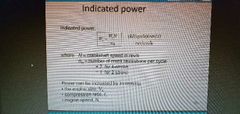
Indicated work |
|
|
How to increase power |
Vd Engine size VdCompression ratio rcEngine speed N Compression ratio rcEngine speed N rc rcEngine speed N Engine speed N |
|
|
Adiabatic gas law |
pV = mRT |
|
|
Equations |
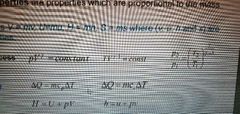
|
|
|
Throttling Process |
Flow process experiencing a pressure drop |
|
|
Specific fuel consumption |
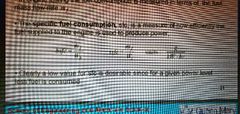
bmep = (2Pi*T*nR)/Vd Wb = (2Pi*N)*T |
|
|
Thermal efficiency |
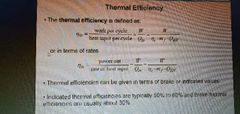
|
|
|
Combustion efficiency |
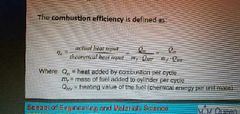
|
|
|
Fuel conversion efficiency |
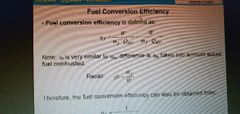
|

